Analyzing Recruitment & Selection in Australian Engineering Firm
VerifiedAdded on 2023/06/14
|7
|1878
|446
Essay
AI Summary
This essay addresses the recruitment and selection challenges faced by a small-to-medium sized Australian-based engineering consultancy. The organization struggles to attract high performers due to increased market competition and cost-cutting measures. The current recruitment process relies heavily on the engineering manager's judgment and a single job advertisement website (Seek.com.au). The essay identifies several key issues, including the limited use of recruitment channels, disregard for professional HR practices, outdated job descriptions, and inefficient selection methods. It recommends updating job descriptions, implementing a comprehensive recruitment strategy, utilizing multiple selection tools, and creating an attractive employee value proposition to improve talent acquisition and address the organization's challenges. The essay concludes that addressing these failures in the recruitment and selection process is crucial for the organization to attract and retain top talent.
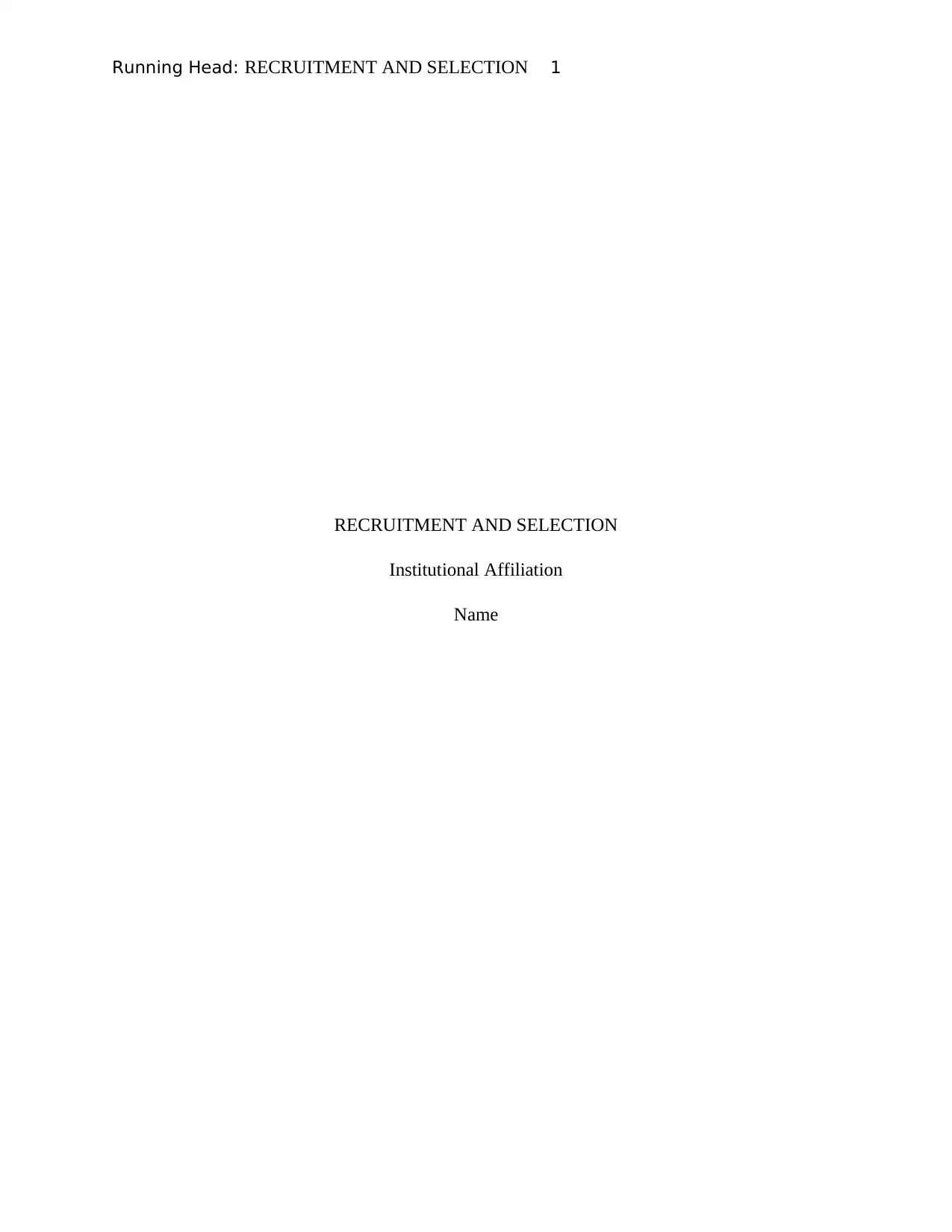
Running Head: RECRUITMENT AND SELECTION 1
RECRUITMENT AND SELECTION
Institutional Affiliation
Name
RECRUITMENT AND SELECTION
Institutional Affiliation
Name
Paraphrase This Document
Need a fresh take? Get an instant paraphrase of this document with our AI Paraphraser
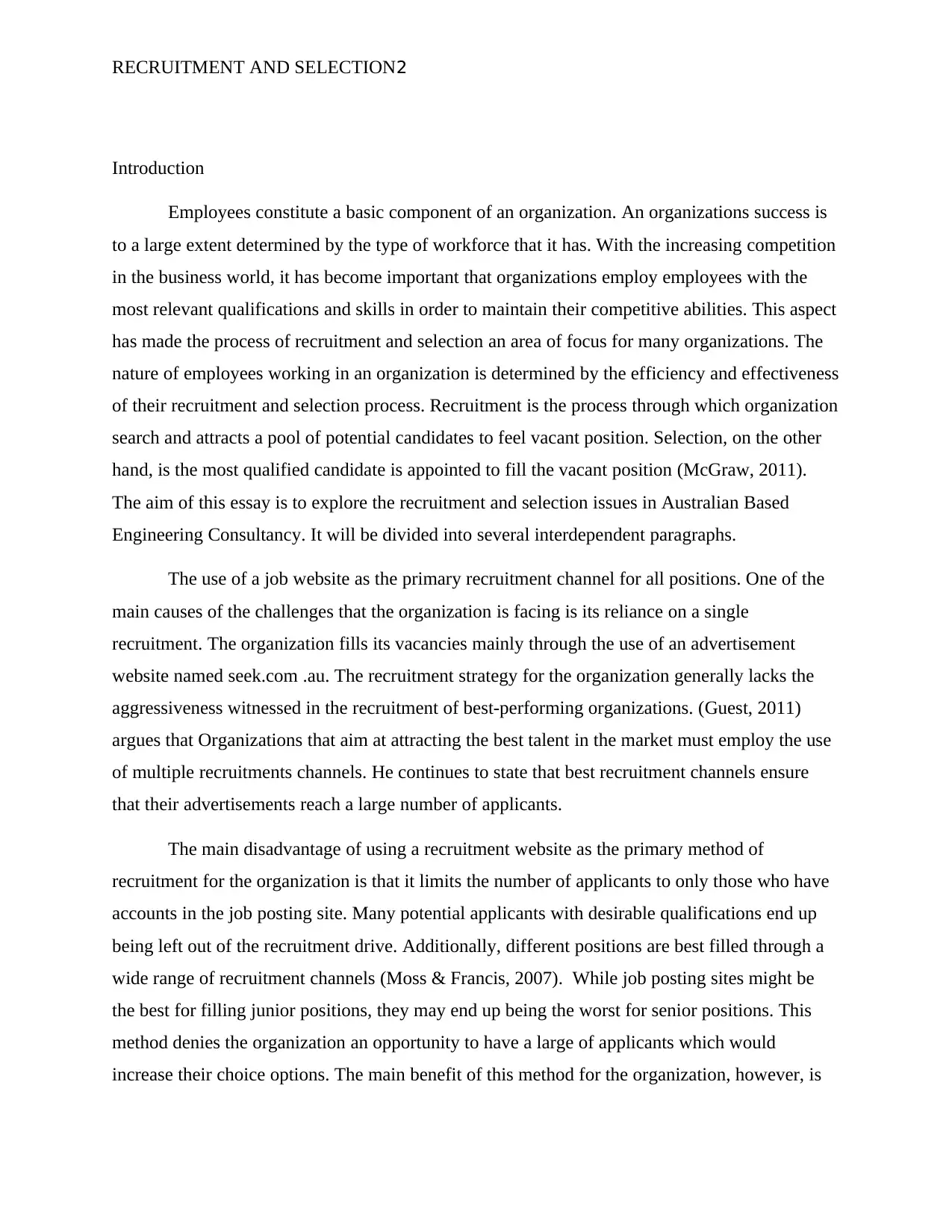
RECRUITMENT AND SELECTION2
Introduction
Employees constitute a basic component of an organization. An organizations success is
to a large extent determined by the type of workforce that it has. With the increasing competition
in the business world, it has become important that organizations employ employees with the
most relevant qualifications and skills in order to maintain their competitive abilities. This aspect
has made the process of recruitment and selection an area of focus for many organizations. The
nature of employees working in an organization is determined by the efficiency and effectiveness
of their recruitment and selection process. Recruitment is the process through which organization
search and attracts a pool of potential candidates to feel vacant position. Selection, on the other
hand, is the most qualified candidate is appointed to fill the vacant position (McGraw, 2011).
The aim of this essay is to explore the recruitment and selection issues in Australian Based
Engineering Consultancy. It will be divided into several interdependent paragraphs.
The use of a job website as the primary recruitment channel for all positions. One of the
main causes of the challenges that the organization is facing is its reliance on a single
recruitment. The organization fills its vacancies mainly through the use of an advertisement
website named seek.com .au. The recruitment strategy for the organization generally lacks the
aggressiveness witnessed in the recruitment of best-performing organizations. (Guest, 2011)
argues that Organizations that aim at attracting the best talent in the market must employ the use
of multiple recruitments channels. He continues to state that best recruitment channels ensure
that their advertisements reach a large number of applicants.
The main disadvantage of using a recruitment website as the primary method of
recruitment for the organization is that it limits the number of applicants to only those who have
accounts in the job posting site. Many potential applicants with desirable qualifications end up
being left out of the recruitment drive. Additionally, different positions are best filled through a
wide range of recruitment channels (Moss & Francis, 2007). While job posting sites might be
the best for filling junior positions, they may end up being the worst for senior positions. This
method denies the organization an opportunity to have a large of applicants which would
increase their choice options. The main benefit of this method for the organization, however, is
Introduction
Employees constitute a basic component of an organization. An organizations success is
to a large extent determined by the type of workforce that it has. With the increasing competition
in the business world, it has become important that organizations employ employees with the
most relevant qualifications and skills in order to maintain their competitive abilities. This aspect
has made the process of recruitment and selection an area of focus for many organizations. The
nature of employees working in an organization is determined by the efficiency and effectiveness
of their recruitment and selection process. Recruitment is the process through which organization
search and attracts a pool of potential candidates to feel vacant position. Selection, on the other
hand, is the most qualified candidate is appointed to fill the vacant position (McGraw, 2011).
The aim of this essay is to explore the recruitment and selection issues in Australian Based
Engineering Consultancy. It will be divided into several interdependent paragraphs.
The use of a job website as the primary recruitment channel for all positions. One of the
main causes of the challenges that the organization is facing is its reliance on a single
recruitment. The organization fills its vacancies mainly through the use of an advertisement
website named seek.com .au. The recruitment strategy for the organization generally lacks the
aggressiveness witnessed in the recruitment of best-performing organizations. (Guest, 2011)
argues that Organizations that aim at attracting the best talent in the market must employ the use
of multiple recruitments channels. He continues to state that best recruitment channels ensure
that their advertisements reach a large number of applicants.
The main disadvantage of using a recruitment website as the primary method of
recruitment for the organization is that it limits the number of applicants to only those who have
accounts in the job posting site. Many potential applicants with desirable qualifications end up
being left out of the recruitment drive. Additionally, different positions are best filled through a
wide range of recruitment channels (Moss & Francis, 2007). While job posting sites might be
the best for filling junior positions, they may end up being the worst for senior positions. This
method denies the organization an opportunity to have a large of applicants which would
increase their choice options. The main benefit of this method for the organization, however, is
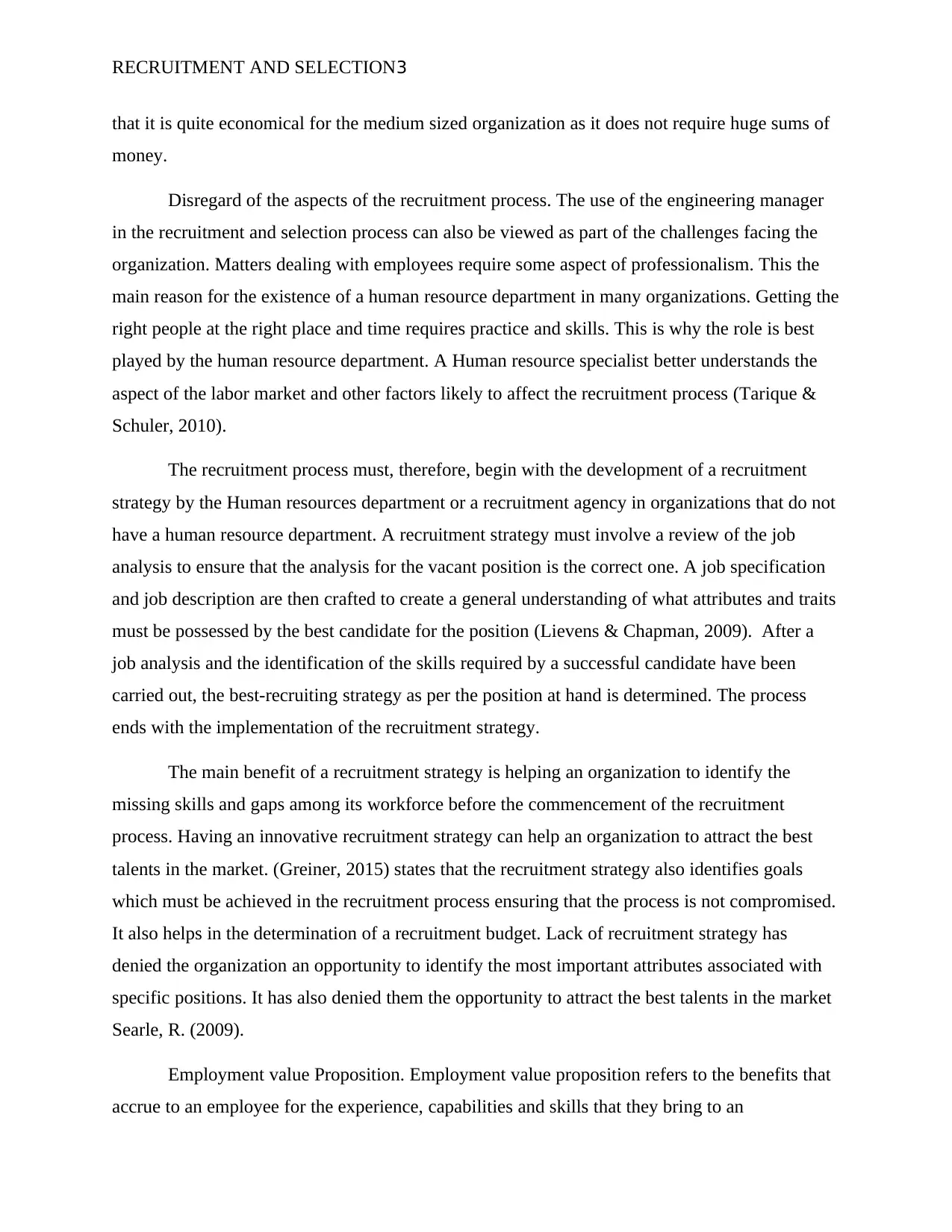
RECRUITMENT AND SELECTION3
that it is quite economical for the medium sized organization as it does not require huge sums of
money.
Disregard of the aspects of the recruitment process. The use of the engineering manager
in the recruitment and selection process can also be viewed as part of the challenges facing the
organization. Matters dealing with employees require some aspect of professionalism. This the
main reason for the existence of a human resource department in many organizations. Getting the
right people at the right place and time requires practice and skills. This is why the role is best
played by the human resource department. A Human resource specialist better understands the
aspect of the labor market and other factors likely to affect the recruitment process (Tarique &
Schuler, 2010).
The recruitment process must, therefore, begin with the development of a recruitment
strategy by the Human resources department or a recruitment agency in organizations that do not
have a human resource department. A recruitment strategy must involve a review of the job
analysis to ensure that the analysis for the vacant position is the correct one. A job specification
and job description are then crafted to create a general understanding of what attributes and traits
must be possessed by the best candidate for the position (Lievens & Chapman, 2009). After a
job analysis and the identification of the skills required by a successful candidate have been
carried out, the best-recruiting strategy as per the position at hand is determined. The process
ends with the implementation of the recruitment strategy.
The main benefit of a recruitment strategy is helping an organization to identify the
missing skills and gaps among its workforce before the commencement of the recruitment
process. Having an innovative recruitment strategy can help an organization to attract the best
talents in the market. (Greiner, 2015) states that the recruitment strategy also identifies goals
which must be achieved in the recruitment process ensuring that the process is not compromised.
It also helps in the determination of a recruitment budget. Lack of recruitment strategy has
denied the organization an opportunity to identify the most important attributes associated with
specific positions. It has also denied them the opportunity to attract the best talents in the market
Searle, R. (2009).
Employment value Proposition. Employment value proposition refers to the benefits that
accrue to an employee for the experience, capabilities and skills that they bring to an
that it is quite economical for the medium sized organization as it does not require huge sums of
money.
Disregard of the aspects of the recruitment process. The use of the engineering manager
in the recruitment and selection process can also be viewed as part of the challenges facing the
organization. Matters dealing with employees require some aspect of professionalism. This the
main reason for the existence of a human resource department in many organizations. Getting the
right people at the right place and time requires practice and skills. This is why the role is best
played by the human resource department. A Human resource specialist better understands the
aspect of the labor market and other factors likely to affect the recruitment process (Tarique &
Schuler, 2010).
The recruitment process must, therefore, begin with the development of a recruitment
strategy by the Human resources department or a recruitment agency in organizations that do not
have a human resource department. A recruitment strategy must involve a review of the job
analysis to ensure that the analysis for the vacant position is the correct one. A job specification
and job description are then crafted to create a general understanding of what attributes and traits
must be possessed by the best candidate for the position (Lievens & Chapman, 2009). After a
job analysis and the identification of the skills required by a successful candidate have been
carried out, the best-recruiting strategy as per the position at hand is determined. The process
ends with the implementation of the recruitment strategy.
The main benefit of a recruitment strategy is helping an organization to identify the
missing skills and gaps among its workforce before the commencement of the recruitment
process. Having an innovative recruitment strategy can help an organization to attract the best
talents in the market. (Greiner, 2015) states that the recruitment strategy also identifies goals
which must be achieved in the recruitment process ensuring that the process is not compromised.
It also helps in the determination of a recruitment budget. Lack of recruitment strategy has
denied the organization an opportunity to identify the most important attributes associated with
specific positions. It has also denied them the opportunity to attract the best talents in the market
Searle, R. (2009).
Employment value Proposition. Employment value proposition refers to the benefits that
accrue to an employee for the experience, capabilities and skills that they bring to an
⊘ This is a preview!⊘
Do you want full access?
Subscribe today to unlock all pages.

Trusted by 1+ million students worldwide
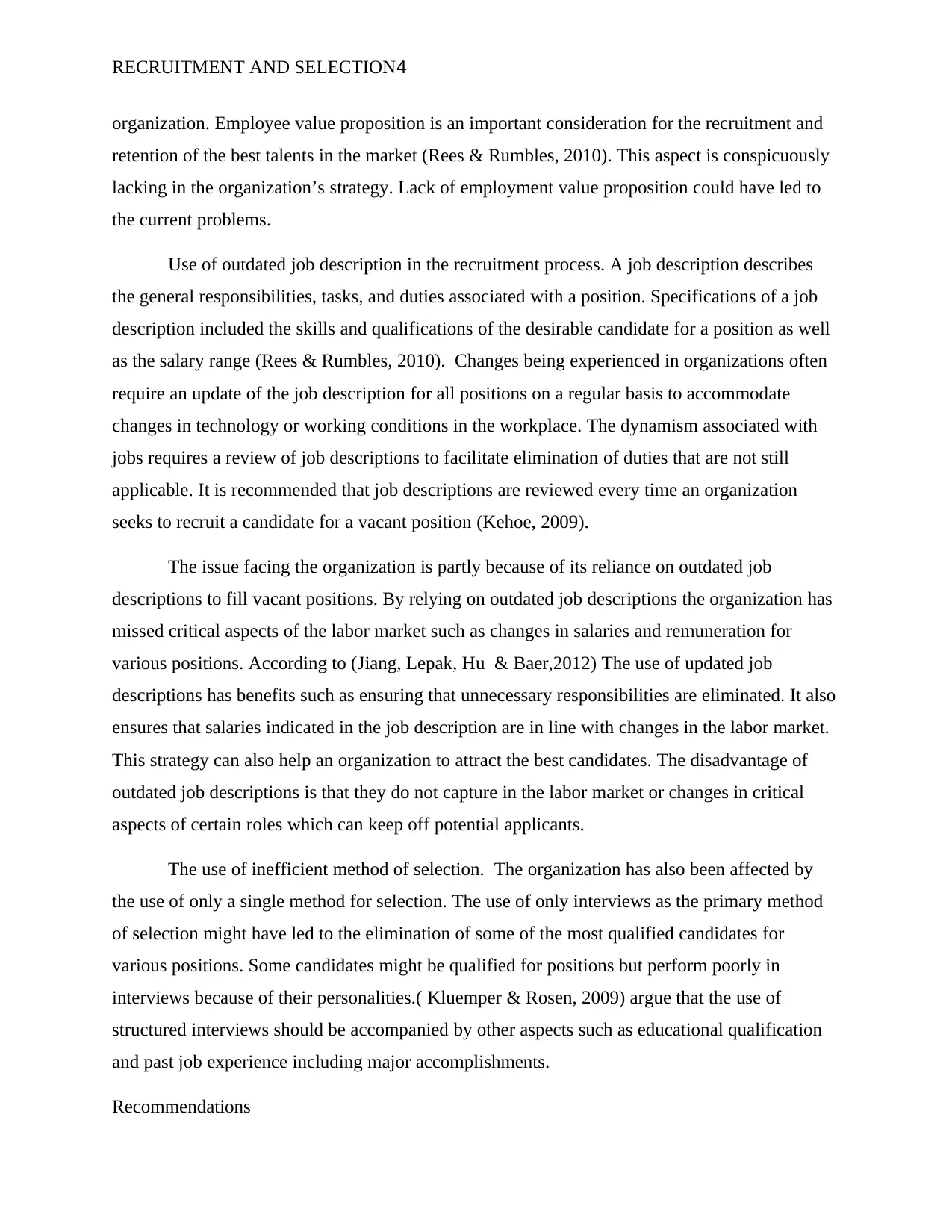
RECRUITMENT AND SELECTION4
organization. Employee value proposition is an important consideration for the recruitment and
retention of the best talents in the market (Rees & Rumbles, 2010). This aspect is conspicuously
lacking in the organization’s strategy. Lack of employment value proposition could have led to
the current problems.
Use of outdated job description in the recruitment process. A job description describes
the general responsibilities, tasks, and duties associated with a position. Specifications of a job
description included the skills and qualifications of the desirable candidate for a position as well
as the salary range (Rees & Rumbles, 2010). Changes being experienced in organizations often
require an update of the job description for all positions on a regular basis to accommodate
changes in technology or working conditions in the workplace. The dynamism associated with
jobs requires a review of job descriptions to facilitate elimination of duties that are not still
applicable. It is recommended that job descriptions are reviewed every time an organization
seeks to recruit a candidate for a vacant position (Kehoe, 2009).
The issue facing the organization is partly because of its reliance on outdated job
descriptions to fill vacant positions. By relying on outdated job descriptions the organization has
missed critical aspects of the labor market such as changes in salaries and remuneration for
various positions. According to (Jiang, Lepak, Hu & Baer,2012) The use of updated job
descriptions has benefits such as ensuring that unnecessary responsibilities are eliminated. It also
ensures that salaries indicated in the job description are in line with changes in the labor market.
This strategy can also help an organization to attract the best candidates. The disadvantage of
outdated job descriptions is that they do not capture in the labor market or changes in critical
aspects of certain roles which can keep off potential applicants.
The use of inefficient method of selection. The organization has also been affected by
the use of only a single method for selection. The use of only interviews as the primary method
of selection might have led to the elimination of some of the most qualified candidates for
various positions. Some candidates might be qualified for positions but perform poorly in
interviews because of their personalities.( Kluemper & Rosen, 2009) argue that the use of
structured interviews should be accompanied by other aspects such as educational qualification
and past job experience including major accomplishments.
Recommendations
organization. Employee value proposition is an important consideration for the recruitment and
retention of the best talents in the market (Rees & Rumbles, 2010). This aspect is conspicuously
lacking in the organization’s strategy. Lack of employment value proposition could have led to
the current problems.
Use of outdated job description in the recruitment process. A job description describes
the general responsibilities, tasks, and duties associated with a position. Specifications of a job
description included the skills and qualifications of the desirable candidate for a position as well
as the salary range (Rees & Rumbles, 2010). Changes being experienced in organizations often
require an update of the job description for all positions on a regular basis to accommodate
changes in technology or working conditions in the workplace. The dynamism associated with
jobs requires a review of job descriptions to facilitate elimination of duties that are not still
applicable. It is recommended that job descriptions are reviewed every time an organization
seeks to recruit a candidate for a vacant position (Kehoe, 2009).
The issue facing the organization is partly because of its reliance on outdated job
descriptions to fill vacant positions. By relying on outdated job descriptions the organization has
missed critical aspects of the labor market such as changes in salaries and remuneration for
various positions. According to (Jiang, Lepak, Hu & Baer,2012) The use of updated job
descriptions has benefits such as ensuring that unnecessary responsibilities are eliminated. It also
ensures that salaries indicated in the job description are in line with changes in the labor market.
This strategy can also help an organization to attract the best candidates. The disadvantage of
outdated job descriptions is that they do not capture in the labor market or changes in critical
aspects of certain roles which can keep off potential applicants.
The use of inefficient method of selection. The organization has also been affected by
the use of only a single method for selection. The use of only interviews as the primary method
of selection might have led to the elimination of some of the most qualified candidates for
various positions. Some candidates might be qualified for positions but perform poorly in
interviews because of their personalities.( Kluemper & Rosen, 2009) argue that the use of
structured interviews should be accompanied by other aspects such as educational qualification
and past job experience including major accomplishments.
Recommendations
Paraphrase This Document
Need a fresh take? Get an instant paraphrase of this document with our AI Paraphraser
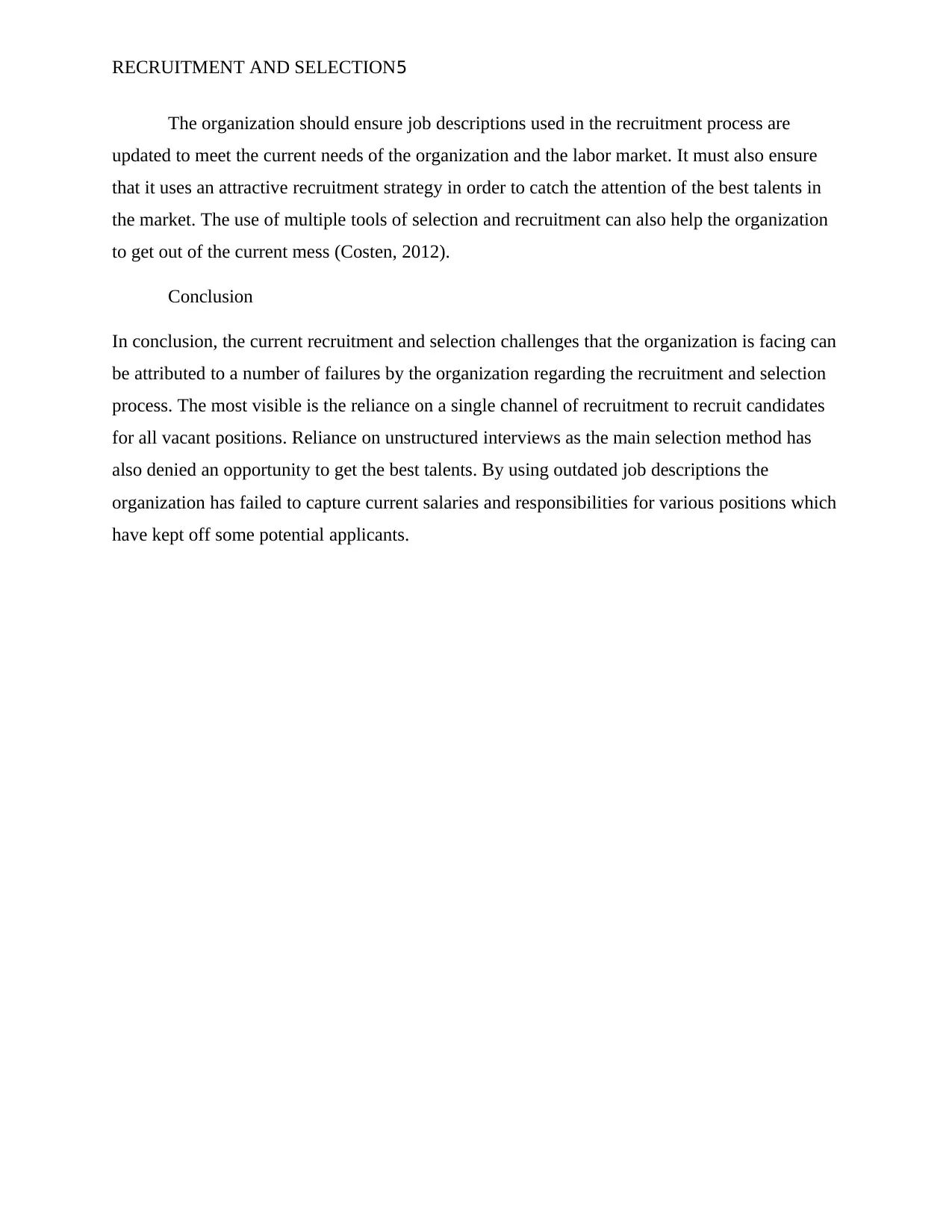
RECRUITMENT AND SELECTION5
The organization should ensure job descriptions used in the recruitment process are
updated to meet the current needs of the organization and the labor market. It must also ensure
that it uses an attractive recruitment strategy in order to catch the attention of the best talents in
the market. The use of multiple tools of selection and recruitment can also help the organization
to get out of the current mess (Costen, 2012).
Conclusion
In conclusion, the current recruitment and selection challenges that the organization is facing can
be attributed to a number of failures by the organization regarding the recruitment and selection
process. The most visible is the reliance on a single channel of recruitment to recruit candidates
for all vacant positions. Reliance on unstructured interviews as the main selection method has
also denied an opportunity to get the best talents. By using outdated job descriptions the
organization has failed to capture current salaries and responsibilities for various positions which
have kept off some potential applicants.
The organization should ensure job descriptions used in the recruitment process are
updated to meet the current needs of the organization and the labor market. It must also ensure
that it uses an attractive recruitment strategy in order to catch the attention of the best talents in
the market. The use of multiple tools of selection and recruitment can also help the organization
to get out of the current mess (Costen, 2012).
Conclusion
In conclusion, the current recruitment and selection challenges that the organization is facing can
be attributed to a number of failures by the organization regarding the recruitment and selection
process. The most visible is the reliance on a single channel of recruitment to recruit candidates
for all vacant positions. Reliance on unstructured interviews as the main selection method has
also denied an opportunity to get the best talents. By using outdated job descriptions the
organization has failed to capture current salaries and responsibilities for various positions which
have kept off some potential applicants.
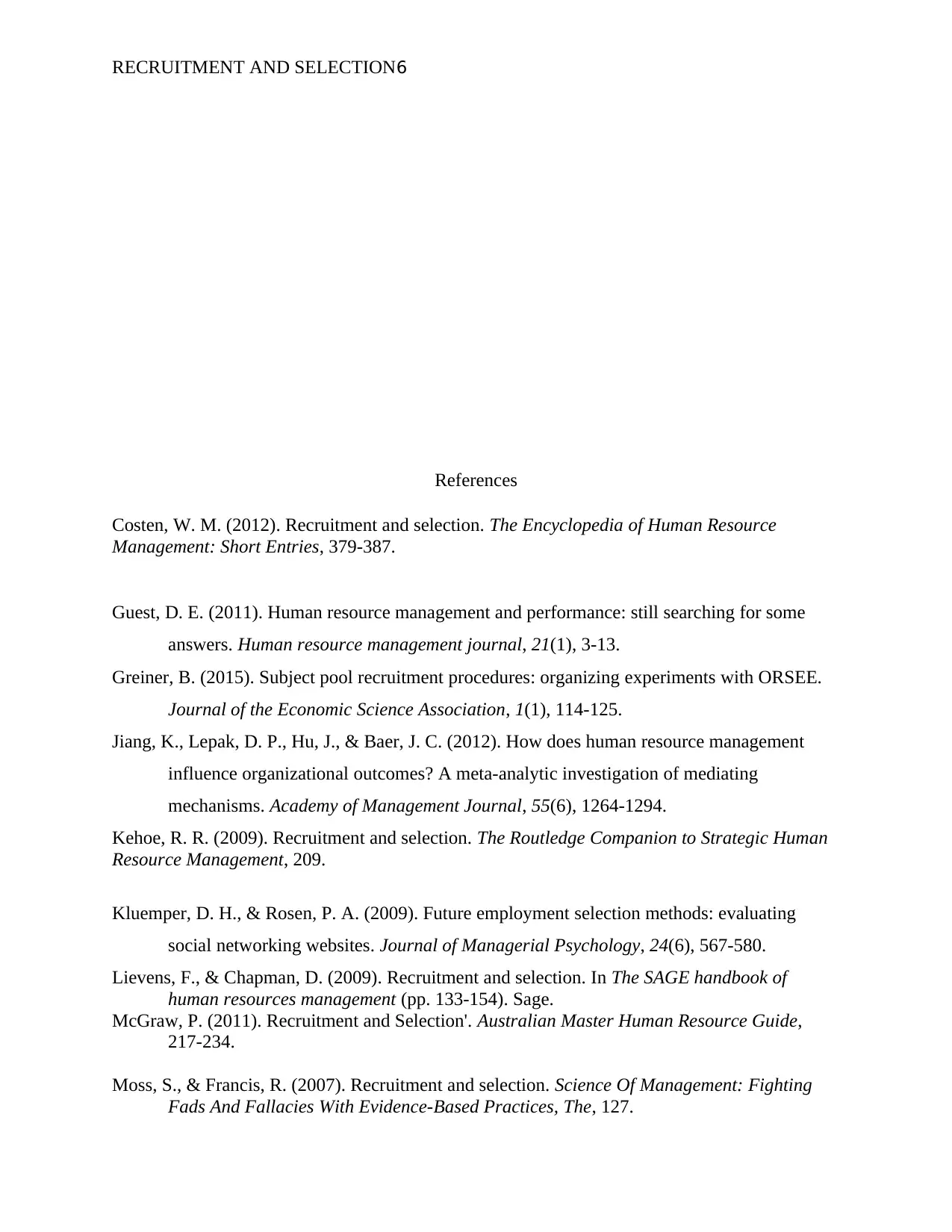
RECRUITMENT AND SELECTION6
References
Costen, W. M. (2012). Recruitment and selection. The Encyclopedia of Human Resource
Management: Short Entries, 379-387.
Guest, D. E. (2011). Human resource management and performance: still searching for some
answers. Human resource management journal, 21(1), 3-13.
Greiner, B. (2015). Subject pool recruitment procedures: organizing experiments with ORSEE.
Journal of the Economic Science Association, 1(1), 114-125.
Jiang, K., Lepak, D. P., Hu, J., & Baer, J. C. (2012). How does human resource management
influence organizational outcomes? A meta-analytic investigation of mediating
mechanisms. Academy of Management Journal, 55(6), 1264-1294.
Kehoe, R. R. (2009). Recruitment and selection. The Routledge Companion to Strategic Human
Resource Management, 209.
Kluemper, D. H., & Rosen, P. A. (2009). Future employment selection methods: evaluating
social networking websites. Journal of Managerial Psychology, 24(6), 567-580.
Lievens, F., & Chapman, D. (2009). Recruitment and selection. In The SAGE handbook of
human resources management (pp. 133-154). Sage.
McGraw, P. (2011). Recruitment and Selection'. Australian Master Human Resource Guide,
217-234.
Moss, S., & Francis, R. (2007). Recruitment and selection. Science Of Management: Fighting
Fads And Fallacies With Evidence-Based Practices, The, 127.
References
Costen, W. M. (2012). Recruitment and selection. The Encyclopedia of Human Resource
Management: Short Entries, 379-387.
Guest, D. E. (2011). Human resource management and performance: still searching for some
answers. Human resource management journal, 21(1), 3-13.
Greiner, B. (2015). Subject pool recruitment procedures: organizing experiments with ORSEE.
Journal of the Economic Science Association, 1(1), 114-125.
Jiang, K., Lepak, D. P., Hu, J., & Baer, J. C. (2012). How does human resource management
influence organizational outcomes? A meta-analytic investigation of mediating
mechanisms. Academy of Management Journal, 55(6), 1264-1294.
Kehoe, R. R. (2009). Recruitment and selection. The Routledge Companion to Strategic Human
Resource Management, 209.
Kluemper, D. H., & Rosen, P. A. (2009). Future employment selection methods: evaluating
social networking websites. Journal of Managerial Psychology, 24(6), 567-580.
Lievens, F., & Chapman, D. (2009). Recruitment and selection. In The SAGE handbook of
human resources management (pp. 133-154). Sage.
McGraw, P. (2011). Recruitment and Selection'. Australian Master Human Resource Guide,
217-234.
Moss, S., & Francis, R. (2007). Recruitment and selection. Science Of Management: Fighting
Fads And Fallacies With Evidence-Based Practices, The, 127.
⊘ This is a preview!⊘
Do you want full access?
Subscribe today to unlock all pages.

Trusted by 1+ million students worldwide
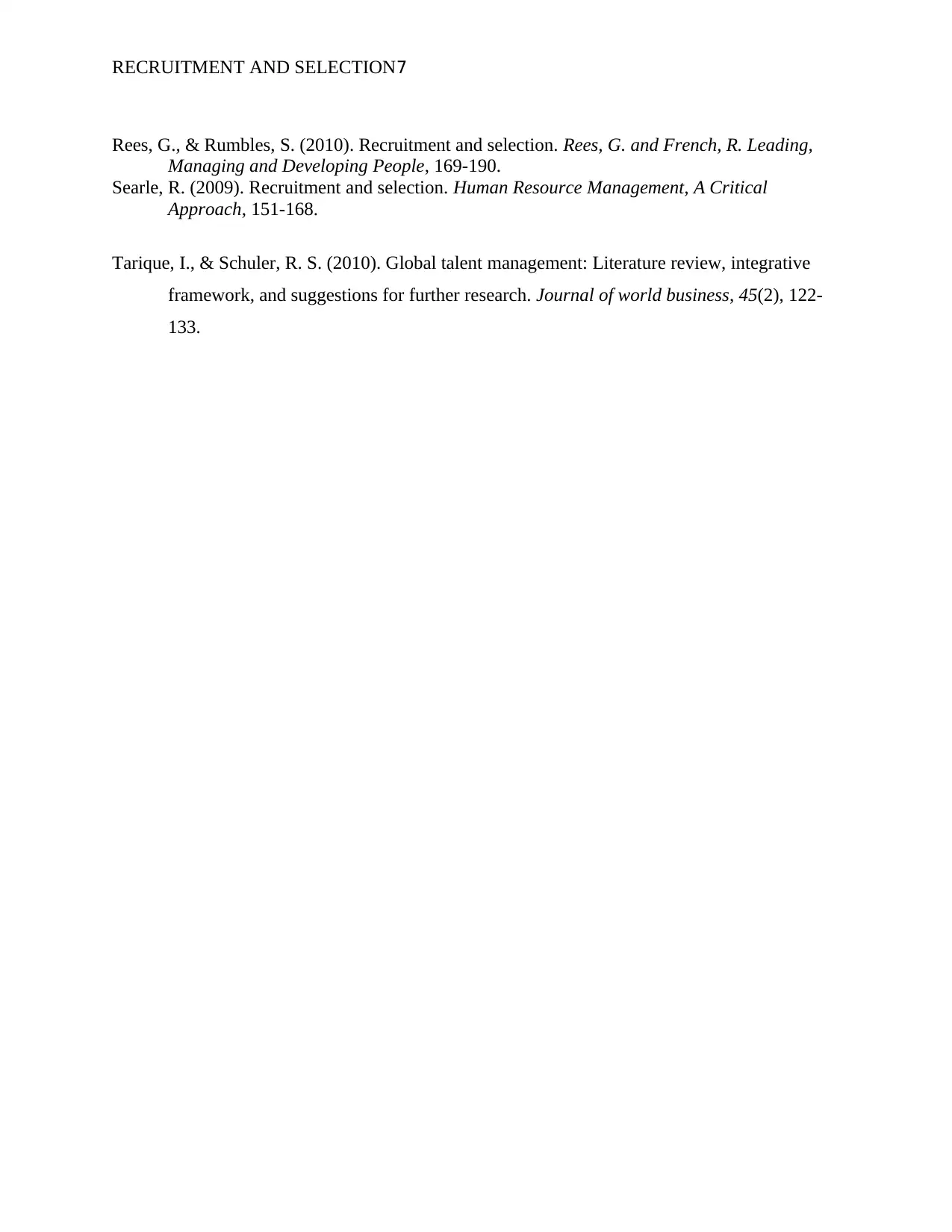
RECRUITMENT AND SELECTION7
Rees, G., & Rumbles, S. (2010). Recruitment and selection. Rees, G. and French, R. Leading,
Managing and Developing People, 169-190.
Searle, R. (2009). Recruitment and selection. Human Resource Management, A Critical
Approach, 151-168.
Tarique, I., & Schuler, R. S. (2010). Global talent management: Literature review, integrative
framework, and suggestions for further research. Journal of world business, 45(2), 122-
133.
Rees, G., & Rumbles, S. (2010). Recruitment and selection. Rees, G. and French, R. Leading,
Managing and Developing People, 169-190.
Searle, R. (2009). Recruitment and selection. Human Resource Management, A Critical
Approach, 151-168.
Tarique, I., & Schuler, R. S. (2010). Global talent management: Literature review, integrative
framework, and suggestions for further research. Journal of world business, 45(2), 122-
133.
1 out of 7
Related Documents
Your All-in-One AI-Powered Toolkit for Academic Success.
+13062052269
info@desklib.com
Available 24*7 on WhatsApp / Email
![[object Object]](/_next/static/media/star-bottom.7253800d.svg)
Unlock your academic potential
Copyright © 2020–2025 A2Z Services. All Rights Reserved. Developed and managed by ZUCOL.





